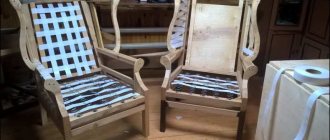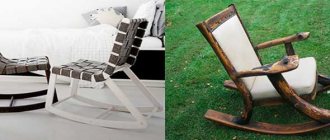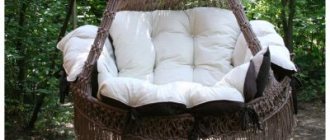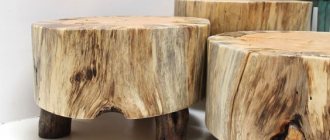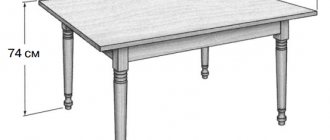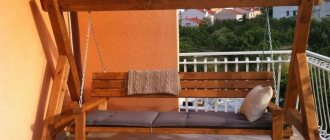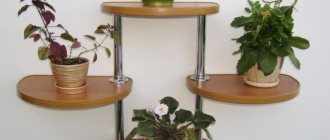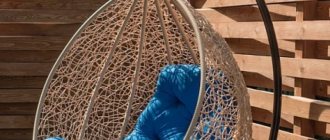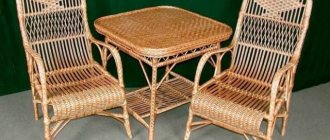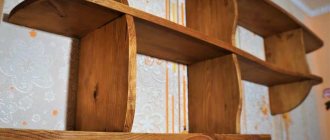There is always a lot of work to do at the dacha or in the garden. But many people acquired these things not only to work there constantly. In my dreams of a dacha, it was imagined as a place for family vacations, meeting friends, reading books and just listening to the birds. The garden is a place for peace of mind. And a mandatory attribute of this picture is comfortable garden furniture, which with its whole appearance reminds you that it’s time to relax and drink a cup of tea. Today we will look at step-by-step instructions for making a wooden chair, such as the one in the photo below. It can also be used as an interesting lounge chair.
Peculiarities
The simplest garden furniture is outdoor benches used in parks and squares. However, gardeners and vegetable gardeners often make chairs, benches, and benches designed for use in the garden, and not just on the veranda or gazebo.
Handmade, rustic furniture is much more durable than what you buy in furniture stores. In order to save money, furniture is often made from chipboard, somehow protected from moisture by an adhesive layer of film.
Sometimes wood dust is used together with plastic - scraps from other products, such as lumber. Both materials are diluted with epoxy resin or glue: for example, interior doors are cast. Establishing the production of such furniture for a summer house is not a problem: the slats and boards merged in this way have longitudinal voids inside and a box-shaped profile in cross-section.
However, natural wood, well dried and impregnated with a bioprotective composition (against microbes, fungi, mold), coated with a waterproof varnish that can last for years even in heat, frost and humidity, will last at least several decades.
An example is the same Soviet stores installed in city parks in the 70s of the last century, which in some places have survived to this day. There are no special secrets to their durability. These stores were painted with street paint every two years. Resistant to fading under conditions of annual changes in temperature, humidity and ultraviolet radiation.
Finally, making garden furniture is a test of the skills of a true owner. If you are a handyman, you can make a chair, for example, by having a dozen large pieces of wood after replacing the floors in the rooms.
What kind of chairs can you make with your own hands?
Before you start working, you need to clearly understand what types of wooden chairs can really be made at home:
- soft. Convenient option for home. For manufacturing, you will need to assemble a frame on which the soft upholstery will be attached;
- sliding An excellent option for saving space in the house. Their design is somewhat more complex than that of an ordinary wooden chair;
- folding. Just right for going out into nature. The complexity of manufacturing is compensated by its functionality;
- Kentucky. A simple construction of materials will require only bars. Wire or pins act as fasteners;
- on wheels - an option convenient for the elderly and disabled. The most critical stage in manufacturing will be the correct installation of the wheels, because such a chair should move effortlessly.
You can slightly modify an ordinary chair by attaching a high back to it. Both hard and soft models are made, it all depends on the imagination and skills of the master.
Sometimes you want to make a rocking chair with your own hands. The main difficulty here is preparing the arched base. But this problem can also be solved.
Step-by-step instruction
Step 1. Preparing the bars.
First of all, it is necessary to prepare bars of the required section and length. This is necessary for our folding “chaise lounge” to be comfortable. The length and required number of bars are shown in the table:
| pp | Brand | Detail | Amount | Length | Section, mm |
| 1. | Seat | 45 x 33 | |||
| 1.1. | a | Seat | 6 | 375 mm | 45 x 33 |
| 1.2. | b | Seat - rear legs | 2 | 875 | 45 x 33 |
| 2. | Back | 45 x 33 | |||
| 2.1. | c | Back - long | 4 | 787 mm | 45 x 33 |
| 2.2. | d | Back - short | 2 | 745 | 45 x 33 |
| 2.3. | e | Back - front legs | 2 | 1050 mm | 45 x 33 |
| 3. | Compound | 45 x 33 | |||
| 3.1. | f | Connecting | 9 | 228 mm | 45 x 33 |
Step 2: Drilling Holes.
After the bars are cut, they are sorted by length and placed into separate piles.
To connect the bars to each other, a wire is used, on which the bars are strung in a certain order. To do this you need to drill holes. The diameter of the hole should be 2 mm larger than the thickness of the wire, so for a wire with a diameter of 4 mm you need to drill a hole of 6 mm.
The holes are drilled on a wide plane of the block, the width of which is 45 mm. The holes must be placed exactly in the center of the bar and drilled strictly perpendicular to the surface. Otherwise, the connection will be uneven and not strong.
Hole pattern
We take the bars that belong to the “Seat” and “Back” parts. The first hole is drilled at a distance of 37 mm from the edge. The second hole is drilled:
- for bars of the “Seat” part at a distance of 300 mm from the center of the first hole;
- for bars of the “Back” part at a distance of 625 mm from the center of the first hole.
For transition bars:
- the first hole is drilled at a distance of 31 mm from the edge of the block;
- the second hole is at a distance of 166 mm from the center of the first hole.
Now you can begin assembling the chair-chair.
Step3. We unfold and assemble the “Seat” part.
We take bars (a) and (c), which belong to the “Seat” part and lay them out in a row in the following order:
- two bars (a) 375 mm long;
- then one block (c) 875 mm long;
- then again two bars (a);
- one block (c);
- two bars (a).
Thus, the bars should be laid out in the following order: (a), (a), (b), (a), (a), (b), (a), (a). There are eight bars in total.
We lay out the bars so that the first hole, which is located at a distance of 37 mm from the edge, is on one side for all bars. You need to align the bars along the edge and pull the wire through the hole. This will be the front of the "Seat".
Step 4. Attach transition bars to the “Seat”.
We take the transition bars (f), there are nine of them, and place them between the “Seat” bars. Transition bars should begin and end the row. The layout order will be as follows: (f), (a), (f), (a), (f), (b), (f), (a), (f), (a), (f) , (b), (f), (a), (f), (a), (f).
We align the bars so that the holes of adjacent bars coincide and connect them with wire.
If you understand the layout diagram correctly, you can try to lay out all the bars at once, align the holes and stretch the wire.
Step 5. Assembling the “Back”.
Now we take bars (c), (d and (e) which belong to the “Back” part. We lay out the bars in the following order: (e), (c), (d), (c), (c), (d) , (c), (e). Again, make sure that all the bars have the first hole, which is located at a distance of 37 mm from the edge, on one side. We level the bars and connect them with wire, pulling it through the first hole of each bar This part will then be the top of the “Back”.
Step 6. Putting the parts together.
We take the “Back” by its upper part and carefully place the “Back” on top of the “Seat”. It is necessary to apply it in such a way that the top of the “Back” is located above the front part of the “Seat”, and, accordingly, the bottom of the “Back” is located above the back part of the “Seat”, to which the transition bars are attached.
In fact, the eight bars of the “Back” should, as it were, lie on the 8 bars of the “Seat”.
Now we move apart the transition bars “Seats” one by one and place the bars “Backs” between them. The outermost ones should be the transition bars on one side and the other.
Now we lift the not yet secured edge of the transition bars and use wire to connect them to the lower part of the backrest.
The chair-chair is now fully assembled. We squeeze the bars of the upper part of the “Back” together so that they fit snugly against each other.
Carefully grasping the top of the “Back” we lift and open our product.
Step 7. Fasten the wire.
The folding wooden chair-chair is almost ready. All that remains is to cut off the excess pieces of wire. The wire is cut using special scissors for cutting metal.
In order to secure the wire, threads must be applied to its edges. To do this, the wire is cut so that it protrudes beyond the bars by 7-10 mm on each side to secure the washer and nut to them.
If threading seems problematic, you can secure the edge of the wire with a staple, which will need to be hammered in well and such a connection will hold well.
This connection is less aesthetically pleasing, but quite reliable.
Step 8. Final.
At this stage we will deal with the finishing touches. If desired, you can use a sanding machine to sand the edges of the seat to give them a rounded shape.
Depending on the intended design, you can simply varnish or paint it.
The item folds easily and does not take up much space when stored.
This chair-chair made of wood can also be made in other design options. Ordinary light - just varnish the wood. Or paint the tree in any color that suits you. The result is a stylish product that can also be used as a chaise lounge.
Main material
The reliability of the future chair, its stability, and ability to cope with loads and various climatic conditions will depend on the choice of wood and the method of final processing. You can use an old chair or armchair as a base, having previously disassembled it into its components, or, conversely, modify existing furniture.
- A material such as chipboard, which is used to make furniture, is not suitable for chairs, especially garden chairs. The reason for this is limited moisture resistance. In addition, chipboard is significantly inferior in strength to laminated and solid wood.
- Natural wood is an absolutely harmless, environmentally friendly material, although not the cheapest. Wood is best suited for making a chair with your own hands. Before starting work, the bars and boards must be inspected for cracks, knots and other defects. Next, the material is sanded, a protective coating is applied, and after that, assembly can begin.
Note! Among all types of wood, preference should be given to alder, ash, birch or oak.
The reason is simple - the unusual pattern of the fibers is combined with the durability and wear resistance of products made from them. It should be added that chairs made of such wood, when properly processed, do not crack over time and do not creak.
Wood is popular in furniture production not only because of its beauty and naturalness. It easily tolerates loads and shocks and is practically resistant to plastic deformation. The only disadvantages are flammability and deformation under the influence of moisture. The last problem is again solved by competent final processing.
Useful tips
Making furniture with your own hands is a very exciting activity. If the process is happening for the first time, make the simplest chair with clear lines and simple geometry. It will be easier to work, and the result will be neat.
Having experience in carpentry, you can surprise your family and friends with unusual shapes. The handcrafted round chair is effective and practical in any setting. Another easy way is to make a chair out of a car seat left in the garage.
By being creative and following the instructions, you can make a chair with your own hands that will be used for its intended purpose for many years. In addition, a product made with your own hands will become a source of pride for the owners and a source of pride for friends.
Simple chair for the garden
Having decided to make a chair for the dacha with your own hands from wood, having selected the drawings, you should not immediately take on complex projects. The first pancake is often lumpy, and to get the hang of it, you can try to implement the simplest options.
The simplest chair for a summer house consists of curved sides, bases, drawers and slats for the seat. Moreover, the only difficulty lies in cutting out the sidewalls. For production, plywood and wooden planks are used.
The sequence of actions is as follows:
- The sidewalls are cut out with a jigsaw from 30 mm thick euro plywood. Next, the parts are chamfered with an ordinary grinder or a manual milling cutter, after which the future spars are processed with emery cloth;
- the drawers (crossbars holding the sides together) are cut from the same plywood. The result should be 3 parts with dimensions 1200 x 100 mm. Sandpaper comes into play again;
- for a seat that smoothly flows into the back, you need to cut 35 identical strips 1200 mm long. The material will be timber with a section of 50 x 25 mm. The parts are chamfered and the surface is sanded with sandpaper;
- Next, you need to tie the sidewalls together with drawstrings. To do this, points are marked on one of them in three places, which are transferred to the second sidewall. Using an 8 mm drill, drill through holes at the designated points. Using a 5 mm drill, counter holes are drilled at the ends of all frames. Confirmats are used to connect elements;
- It's time to attach the bars that will form the seat. To do this, drill 2 holes on each side of all the blocks, and use self-tapping screws for fastening. To recess the fastener heads into the wood, the holes are pre-countersinked;
- All that remains is to treat the surface of the chair. To remove all cracks and dents, the wood is sanded. Next, the surfaces are treated with fine sandpaper, after which the wood is coated with a primer. The final stage is 3 thin layers of varnish.
Such a homemade chair for a summer house does not require much effort or complex measurements and calculations to make. However, the end result will be a truly chic piece of garden furniture. Experienced craftsmen can try making a more complex garden chair from bent plywood.
This is where both experience working with wood and a truly creative approach to the process will come in handy.
More children...
Children love to feel like adults. If you give them this feeling for a period of long enough painstaking activities (handicrafts, preparing homework), then perseverance will develop. To do this, in Fig. – a child seat, economical, durable and quite comfortable. For the reasons stated above (the child’s skeleton has not yet completely ossified), only soft armrests are allowed; in this case, they are made from covered foam rubber up to 30 mm thick. You don’t need to make it thicker, just as you don’t need to widen the seat and back or make them curved, scoliosis can develop. If your body becomes numb, let it lie on a pouf, pear or ball for half an hour. The key to correct posture is mobility and periodic change of positions.
Drawings of a child seat
The history of children's rocking horses is interesting. Judging by the excavations, they appeared as soon as some primitive innovator first saddled a horse. Initially, their function was purely utilitarian: the initial training of the future equestrian warrior. However, it is still useful for a child to feel like a rider these days; the vestibular apparatus and balance motor skills are developing well. What do the chairs have to do with it? But look how easy it is to make a children's rocking horse chair without any significant costs, see the video:
Video: do-it-yourself baby rocking chair-horse
In addition to developing the vestibular system and sense of balance, the little equestrian will enjoy swaying in a position that prevents deformation of the musculoskeletal system.
Features of a shell-type chair
When making a shell, you will need skill in using a jigsaw, the ability to transfer the dimensions of parts from drawings to the material, and experience in deforming plywood in order to bend it in the correct shapes and directions.
Note! When cutting out parts, it is important to achieve smooth movements of the jigsaw, which is quite difficult for an untrained person.
When making a shell chair without experience working with bent plywood, you can use pieces of scrap wood to train your hand for practice. To fasten the parts of such a chair, wood glue is mainly used, and clamps are used for fixation. You can use self-tapping screws as fasteners, but in this case you will have to drown their heads in the wood fibers.
Once the bent plywood shell chair is fully assembled, all bumps and chips are sanded, after which the surface is cleaned of dirt and dust. To give the product an aesthetic appearance, it is coated with several layers of varnish.
Secrets of reliable upholstery: how to sew
The process of stretching the upholstery of soft chairs has its own nuances:
- Foam rubber is cut to the size of the seat (average thickness - 5 cm). The part is glued to the surface of the plywood sheet.
- Horizontal and vertical fabric straps are secured to the back with a construction stapler. Similar belts are added to the armrests and sides from the inside along the shape.
- A piece is cut from a piece of foam rubber 0.1 cm thick, which will be larger in size than the area of the seat (the difference is 4-5 cm). Take a piece of synthetic padding fabric of a similar size with an elongated front part and fasten it with your own hands.
- After the manipulations have been completed, the upholstery is covered with furniture fabric. Using a stapler, the textiles are secured to all corners of the cover and the synthetic foam layer to the frame of the chair seat.
- The sides and armrests are also covered with padding polyester, secured with aerosol glue over the entire surface. Only after this the parts are sheathed with fabric, securing the flap along the staples.
Application of pallets
To make some chairs, there is no need to look for drawings or practice wood processing. It is enough to take wooden products as a basis, which almost no one pays attention to. One of them is a pallet, or pallet, a rigid wooden container for transporting goods. A chair made from pallets will really look unusual and creative.
Another advantage of using this product is the high quality and strength of the wood from which it is made.
- The pallets are dismantled and all the nails are taken out. The elements of the future chair must be sanded, and then the tray must be assembled in the reverse order.
- The seat of the chair is formed by stacking pallets on top of each other to the desired height (usually 2 pieces are enough). The backrest also serves as a pallet, fixed perpendicular to the seat. By sawing the pallet crosswise into 2 parts, you can use it as armrests.
Before assembly, the parts are varnished in several layers. To ensure that the back and seat are not hard and look really chic, foam pillows in some unusual covers are placed on them.
Finally about the unusual
However, cardboard is very useful in creating chairs. For example, for modeling unique chairs, pos. 1 in Fig. Sheets of cardboard are glued together to the thickness of the chosen plywood or board, cut into blanks and assembled from them into a model, which, of course, cannot be sat on. After fitting, the model is disassembled and a set of templates for cutting the base material is obtained. True, although it is not difficult to fill the gaps of the skeleton with polystyrene foam or polystyrene foam, in order to cover such a chair with soft material and trim it with decorative fabric, you need to be a cutter and an ace seamstress.
Unusual homemade chairs
Armchairs made of felt or overcoat cloth, pos. 2, covered with foam cubes (the seat is supported by a hidden plywood insert), pos. 3, or water pipes, pos. 4, already require more invention than high skill. Felt and tubular, of course, will cost a pretty penny. But a chair made from cubes can be made even by less than adult craftsmen and craftswomen. And a hand-made chair for my mother’s birthday – it really couldn’t be cooler.
In general, the chairs, even without reaching complex representative ones, give scope for creative self-expression like few other pieces of furniture and homemade products in general. So, since the chairs are on the way, create, invent, try!
Decor options
It should be said that even for such chairs, appearance is an extremely important aspect. At the same time, it is not necessary to buy any accessories for this at an exorbitant price. To do this, you can use some old unnecessary things. For example, the same pillows and bedspreads to make the chair not only beautiful, but also soft. For example, you can cover the seat and back with padding polyester, and simply stretch decorative fabric over this material.
It is better to fasten such upholstery using the simplest furniture stapler.
About padding and covers
Any soft chair, on a rigid base or frameless (see below), is filled with soft and fairly elastic material. Horse hair is now available to only a few, whalebone is not available to anyone at all, so amateur chairs are most often stuffed with foam rubber or polystyrene foam (foamed polystyrene) in granules. They have a common property: they are easily electrified and retain static electricity for a long time, which is not at all good for health. Therefore, the upholstery of pillows, mats, and other soft furniture components must be made of 2 layers: external decorative and internal antistatic. This, in addition, simplifies the maintenance of decorative cladding and its replacement if necessary.
The antistatic cover of upholstered furniture is sewn from cotton fabrics according to the same patterns as the decorative one. There are almost no alternatives to cotton as a surge arrester: the leakage resistance of a chair on wooden legs, standing on a laminate floor, with an outer covering made of very well-electrified silk, with an internal cotton cover, lies in the range of 1.8 - 5.6 MOhm , which ensures almost instantaneous charge drain from the electrophore machine. Synthetic winterizer is somewhat worse: it does not rot, but the outer covering should also be antistatic, made from natural furniture fabrics.
The antistatic filler of upholstered furniture, remarkable in its mechanical properties and in itself, is polyurethane foam (PPU). But not a construction self-foaming sealant/thermal insulator; mechanically it is not suitable for furniture, but the so-called. neoprene foamed under special conditions during manufacture. Neoprene is available in granules and sheets; The latter, by the way, are used to make wetsuits. The material is expensive, especially sheet material, but there is no need for invention. Car seat inserts are made of neoprene. So if you come across a junkyard jalopy, try to get your hands on the seats and backrests. They won’t be counted as metal anyway, but by shredding the inserts you’ll get excellent padding for a couple of chairs.
For more information on sewing chair covers, we recommend a separate material at the link.
Recommendations
- Here are some useful tips that will make it even easier to make a chair from wood with your own hands. To begin with, let's say that before creating any structure made of wood, you should carefully think about how it will roughly look and what you want to see it as. This will allow you to at least approximately determine how much of a particular material you need.
- Another important aspect is that you should not neglect such a thing as drawings. For some reason, many people do not pay enough attention to them, which is why they end up with crooked chairs and armchairs. In this matter, everything should be thought through to the smallest detail and the parameters of each detail should be checked. It would not be superfluous to say that it would be better to use a circular saw for cutting longitudinal parts, and a jigsaw for transverse parts.
- Another important issue concerns the connection of the chair elements. Everything is quite simple here. In connections where the main load occurs, it is better to use self-tapping screws or self-tapping screws. But in other cases, you can use adhesive or chopsticks made of wood. Choppers can also be used to secure the upper parts.
- An important point will be the selection of materials for processing. But here everything will depend on how high-quality the wood is used. If it is “clean” and has no defects, then it will be enough to treat it with stain and apply varnish. But if there are stains on it and there are some defects, then you should putty them, then cover them with a primer and only then paint. Another important point is that you should not paint the wood right away. It must be pre-treated with drying oil. Otherwise, it will quickly be absorbed into the surface. Then there will be bald spots, which will ruin the appearance of the chair.
Choosing a model
There are many different options for wooden chairs. They all differ in type of design, design, and the presence of additional parts.
Table 1. Models of wooden products
| View, illustration | Description |
On a frame with rigid parts | Such structures are characterized by good wear resistance; they rarely deform even as a result of constant use. Such products are installed in dining rooms, offices and other premises. Antique-made furniture pieces are especially popular. To do this, they use various paints in cans and special design techniques. |
With fabric upholstery and soft filling | These are very comfortable chairs, they have an aesthetic appearance. Compared to the previous model, this product requires more careful care, otherwise it will quickly lose its original appearance. Such designs can be placed in any type of room: in the living room, children's room, even in the kitchen. The model involves a solid frame, and the seat, back, and armrests are upholstered with soft material. In addition, the products differ in the degree of filling. |
Table 2. Product types by design features
| View, illustration | Description |
Folding | These are very compact structures that have a folding mechanism, due to which they can be moved without any problems. Such designs will be appreciated by travelers and lovers of country holidays. |
Sliding | Such products are ergonomic and suitable for small spaces. Similar designs come with a rigid frame or with soft upholstery. |
Kentucky | This product has an unusual appearance and is easy to manufacture. The process uses hardwood and wire. This chair is ideal for a cottage or country house. |
With high support | Pieces of furniture of this type have a truly royal appearance, because they resemble a high throne. They are made of wood and then can be upholstered with soft fabric. An armchair with high support will fit perfectly into any classic-style interior. |
Rocking chair | The main feature of this product is the arched legs. Making it yourself is quite difficult, because not every beginner will be able to achieve the correct rounded shape of wooden blocks. This activity requires certain skills, but the result will be magnificent, and the rocking chair will become a favorite resting place for all family members. |
DIY rocking chair
During the manufacturing process the following will be required:
- plywood sheets;
- cardboard;
- putty;
- dye;
- pencil;
- ruler;
- tape measure;
- sandpaper
- jigsaw;
- fasteners;
- drill.
Step-by-step instruction
Step one: prepare the details. The entire structure of the chair consists of two side parts, three horizontal connecting strips and 35 crossbars (needed to create the seat).
In this design, the most labor-intensive stage is the creation of the sidewalls, so it is recommended to mark them on cardboard, then cut them out, and only then transfer them to the wood.
Step two: to make the side parts you need to take multi-layer plywood 3 centimeters thick. Then you should transfer the part from the cardboard to a plywood sheet and carefully cut it out with an electric jigsaw.
Step three: after which the side parts must be thoroughly sanded with sandpaper and their edges trimmed using a grinder or milling equipment.
Step four: from plywood of the same thickness you will need to make horizontal connecting strips 120 centimeters long and 10 centimeters wide. After which they need to be sanded with sandpaper, but you should not process the edges with a router.
Step five: you need to take a block of wood 5×2.5 centimeters and cut it into 35 pieces, 120 centimeters each. After which they should be sanded and the edges removed.
Step six: in the middle part of the outer arc of the sidewalls, at the back and near the legs, we mark the places where the horizontal strips are fixed. After which these marks should be duplicated on the other side. Then you can make holes for the fasteners.
Step seven: we make through holes on the end parts of the sidewalls, and then we connect the frame with horizontal strips using screws.
Step eight: next you need to take the bars that we prepared earlier and attach them one by one to the seat with self-tapping screws.
Step Nine: The last step will be thorough surface treatment. To do this, you must first fill all the holes and go over the wood with sandpaper. Then the surface is coated with a primer and several layers of varnish.
Pattern with detailed dimensions for children and adults
To make a pear chair you will need to make a pattern.
You can draw it yourself or find a ready-made version on the Internet. The pattern is drawn on graph paper. And then it is transferred to the fabric. The parts are cut along the contour.
Attention: when transferring the pattern to the fabric, do not forget to leave allowances of a few centimeters on each side.
The pattern of a chair for an adult will consist of the following parts:
- 6 pieces of wedge-shaped parts, 15 cm wide and 40 at the ends, with a diameter of 50 cm and a length of 130 cm;
- diamond-shaped top 15 cm on each side;
- The bottom is diamond-shaped, 40 cm on each side.
The pattern of a chair for a child will consist of the following 6 wedge-shaped parts:
- height – 90 cm;
- diameter – 45 cm;
- width – 40-22 cm.
The bean bag chair consists of:
- Internal zippered cover filled with polystyrene foam. Here you should choose thick cotton or raincoat fabric.
- Outer cover. Suitable for manufacturing: corduroy, leather, velor. You will need to sew a 1 meter long zipper onto the removable cover.
Solid wood chair
Making any furniture from solid wood at home will require a lot of time and effort from the craftsman, as well as the availability of special tools and equipment. In fact, the array can be used by beginners in their work, but the same chairs without the use of finishing techniques will look, to put it mildly, boring.
But if you decorate the products with various cuts and use wood carving skills, you can achieve a good look.
To fasten parts made from solid wood, one of two main methods is used.
- Bonding - gluing elements together with edges pre-processed on a jointer. This option is the simplest. To connect two parts, you need to form a ridge on one of them, and a groove on the other. As an option, two grooves are made into which the strip is inserted.
- The second method is docking. Wood glue and wooden dowels are used.
Folding design
Together with classic folding chairs, you can independently make a Kentucky-type folding chair that is simpler in design, but with an unusual appearance. It will require bars of the same cross-section, which must be cut in accordance with the selected drawing. 4 long pins are used as fasteners, connecting all the bars together in different places. The rigidity of the structure is adjusted by tightening the nuts on these studs.
In fact, the different Kentucky models are as similar as possible to each other, and most importantly, when assembled they take up minimal space.
Making furniture on your own is a real creative process. With the right amount of imagination, you can turn even old, unwanted chairs into works of art.
This exciting process also saves a lot of money. There is nothing better than combining business with pleasure.
Chairs on radius runners
They are especially popular with avid readers of newspapers and books. The frame can be different: with kinks (when the chair can change shape) and solid. Possible types of products:
- Classic rocking chair. The most common and simple model. It suits both modern and classic. Easy enough to create.
- Chairs with sides (the ends of the rails are bent in the other direction, preventing them from falling backwards). A variety with medium planting height.
- Furniture with elliptical arches. Smooth turning is guaranteed, but may accidentally tip over. Better equipped with bumpers
Materials for making a wooden chair
To make a wooden chair with your own hands, you need to select high-quality raw materials.
Main requirements for wood composition:
- the humidity level should be no more than 9-12%;
- cracks, deformations, branches, fungus on the surface are unacceptable;
- strength, dense structure, ease of processing are important;
- The amount of resin should be small.
It is recommended to buy raw materials with a small reserve, because During the furniture manufacturing process, chips and waste are possible when defects are detected.
- To create a solid wood structure, the grade is important. When creating chairs for the street (gazebo, recreation area), varieties with a dense structure are recommended. An array of elm, pine, oak, walnut, ash, larch, and rowan is suitable.
- For furniture intended for heavy loads, linden and alder wood is needed. Furniture made of yew looks impressive due to its red hue and texture with an original pattern. The dense structure of the array is difficult to process, but is more durable and resistant to mechanical damage.
- Country furniture is made from willow, alder, and rattan. To use the chair in warm climates, grape vines are used, complemented by rattan. Beginning craftsmen are recommended to use bird cherry, because... The material is plastic, easy to bend, durable.
- When preparing furniture for rooms with high humidity or installation near a pond, it is recommended to choose wood with a fine-pored structure. Oak, larch, and solid pine are optimal.
- Spruce chairs are lightweight, easy to process, but have low resistance to mechanical damage and are not resistant to chips and deformations.
Styles
Any piece of furniture should not only be practical, comfortable and safe, but also harmonize with the surrounding interior. You can make a chair with your own hands in any style. But the most popular directions are:
- Loft. This style refers to industrial and industrial. It is characterized by the use of natural and safe materials.
Therefore, the chair must be made of wood, metal or textile. For upholstery, it is recommended to use coarse fabric, such as linen or burlap in gray, white or bright colors.In this direction, chairs made from pallets will look harmonious, as they are distinguished by speed of production, minimal costs and exclusive appearance. Furniture made from profiled pipes also looks good in the interior.
- Provence.
This direction came to us from sunny France. Provence is associated with wheat, poppies, and lavender fields. Natural and safe materials and simple designs are appropriate here. The frame of the chairs is made of natural solid wood. Suitable upholstery options include linen, cotton, and chintz. Their color scheme should be colorful and bright, for example green, turquoise, red, purple, or soft and neutral - the color of fresh milk, golden fields, sandy beaches. A good choice for Provence would be wicker chairs made of rattan or wicker. Forged furniture items will also look beautiful here.
Attention: in the Provence style the use of modern furniture is not allowed. It should have an aged appearance, which can be achieved with patina.
Recommendations for choosing wood
The choice of lumber is a matter of taste, provided that the product has a protective coating. Otherwise, the wood for garden furniture must be resistant to the external environment. In this case, both broad-leaved (chestnut, acacia, oak) and coniferous (false beetle, pine) are optimal.
To make a chair, you can use wooden pallets and pallet elements.
It is better to choose wood based on the available tools. Working with hard rocks without a finger knife, band saw and grinder will be much more difficult - cutting and processing of parts will be delayed and will not be of high quality. Don't forget that garden furniture has to be moved frequently, so the weight of the material is also an important factor when choosing wood.
What is necessary
Before starting the work process, you need to prepare:
- 3 m calico or satin;
- a piece of fabric for covering (approximately 3.5 m);
- zipper 1 m;
- filler;
- material for application;
- scissors, pins, thread and needles.
Check it out here too!
How to make a bench from pallets: do-it-yourself bench from palletsInstructions on how to make a table with your own hands: step-by-step photo instructions, drawings, assembly diagrams for tables of different types for the garden and at home
How to make a hanging chair with your own hands - 100 photo ideas for chair design, instructions for their implementation. Creating the perfect vacation spot
Decorating wooden furniture
An equally important stage in furniture manufacturing is decor. At the same time, it is not necessary to purchase expensive accessories for such purposes, because you can even use old, unnecessary things, pillows.
You can cover the back and seat with padding polyester, and stretch decorative fabric on top. Fasten the upholstery to a wooden structure using a furniture stapler. In addition, the back is sometimes decorated with buttons, which are covered with the same fabric. You can hide the marks from the staples with decorative edging or various laces.
At this stage you will have to show your imagination. You can decorate the surface using paint of different colors - this will allow you to get a unique product that suits your interior specifically.
Advantages and disadvantages
Hand-made reupholstery of home and office furniture has many advantages:
- significant budget savings - it’s easier to buy a couple of meters of textiles and a piece of foam rubber than a whole new chair;
- creative process - independently remaking even the simplest, nondescript chair will help you feel like a real master;
- the possibility of updating the interior - a freshly redesigned chair will be designed exactly as its owner intended;
- A quality restored product will last for many years.
There are also several negative points:
- the product will be very different from the store one - this matters if you want to create a specific model, but the skills are not yet enough;
- the labor-intensive process - if the chair is badly damaged, not only the fabric is replaced, but also the “filling” - foam rubber, springs, while completely disassembling it;
- For work you will need some tools that are not available in every home;
- You will need to organize a workspace, which will then have to be thoroughly cleaned, since the restoration process is quite dusty.
Frequently asked questions from beginning furniture makers
Before you start making this or that design, you should familiarize yourself with the list of questions that beginners in this business often have.
How to cut parts?
When cutting longitudinal parts, it is better to use a circular saw, and for transverse parts, an electric jigsaw.
How to connect parts of the structure?
For connections that carry the main load, you will need to use euroscrews or self-tapping screws. In other cases, the parts are assembled using wooden choppers and glue.
Paint or varnish?
The choice of materials for processing depends on the quality of the wood itself. If the material does not have any defects, it can be treated with stain and then a layer of varnish can be applied. If stains appear on the surface, the wood must first be puttied, coated with a primer, and only then painted.
How to reduce the consumption of paints and varnishes?
Quite often, during final finishing, the paint is quickly absorbed into the surface, which is why bald spots remain on it. This happens because natural wood has a porous structure. That is why professionals recommend pre-treating it with drying oil.
Forms
All chairs are divided into:
round;- semicircular;
- asymmetrical;
- in the form of a pear, apple, drop.
Round models according to the type of placement are divided into:
- Floor-standing. They are equipped with legs and installed on the floor. Some models can be equipped with simple transformation mechanisms. They are diverse not only in appearance, but also in functionality.
- Hanging. They are attached to the ceiling, rack or poles. Some models can swing, others can rotate around their axis. Their frame is made of different materials. Most models are intended to be placed outdoors .
Help : oval chairs are often found in offices. They are distinguished by their original appearance, different types of structures, and a wide selection of materials. Such products fit harmoniously into different stylistic trends and become the main decoration of the room.
